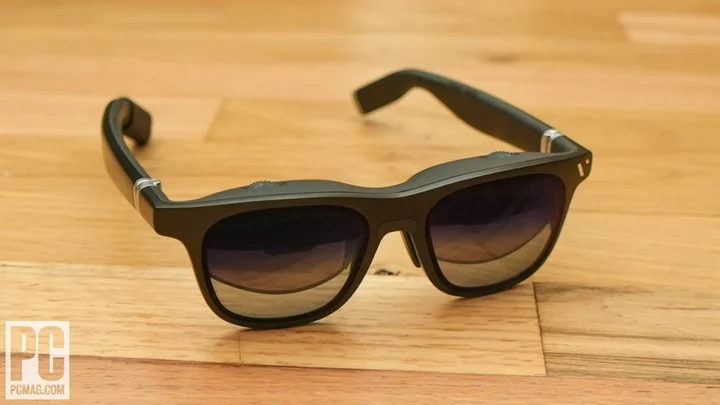Smart glasses have finally started to prove worthwhile, but the category is nebulous thanks to different models functioning as augmented reality headsets, fancy headphones, or social media cameras. The $549 Viture One XR Glasses connect to a computer, a gaming console, or a phone with a USB-C cable and project the screen from your device in front of your eyes. They look like ordinary sunglasses, have built-in speakers, and essentially function as your own discreet, mobile movie theater. Within this subcategory of smart glasses, the Viture One stands out as a favorite thanks to their focus dials that let you adjust the picture without having to order prescription lens inserts, a feature many competitors lack. They're fairly discreet, and they have a neat lens-dimming button that lets you quickly block out distractions without clipping on a separate sunshade. We slightly prefer the $439 Rokid Max, though, which cost less and have a wider field of view. Neither offers a true AR experience that analyzes what's around you to provide contextual information like the Meta Quest 3, but both provide a more comfortable and functional way to privately work or game on the go.
Design: Sunglasses Chic
The Viture One looks like a normal pair of sunglasses, with a simple matte black plastic frame around rectangular two-toned blue/gray and clear lenses. A stylized metallic V sits on the right corner of the frame (when viewed from the front), and matches with silver-colored accents around the glasses’ springy hinges and on the tips of the temples. The temples feature the same matte black plastic as the front, with a slightly rubberized texture on the inside where the glasses touch your skin.
(Credit: Will Greenwald)On the inner surface of the glasses, angled prism lenses direct the downward-facing micro-OLED projectors toward the eyes. You can adjust these lenses with diopters, one of our favorite features to see on AR and video glasses. Two small dials on the top of the frame individually focus the lenses for each eye, so if you’re nearsighted like me you don’t need to buy additional lens inserts or wrestle with finding a focal sweet spot like with the TCL NXTWear S. The Rokid Max also has focus dials that are just as effective at ensuring a clear picture.
A standard nose rest sits between the lenses and features small rubber pads on short wire arms. The Viture One comes with three other nose rest options that you can easily swap out for a good fit. Two larger wire-arm rests can accommodate smaller snouts, while a one-piece rubber arch provides the best fit for larger noses like mine.
Each temple has two small speaker grilles on the top and two microphone slots on the bottom. On the underside of the left temple, you'll find a rocker to adjust the picture's brightness, along with a handy lens-dimming button, my second favorite feature of the glasses. The outward-facing lenses are liquid crystal, and pressing the button switches them from nearly transparent to a dark sunglasses shade. This both obscures any view of what you’re looking at from the outside and blocks out glare without requiring you to pop on an opaque sunshade (which Viture offers as an optional accessory for $19).
Top: See-through lenses. Bottom: Darkened lenses. (Credit: Will Greenwald)The right temple has a magnetic connector on the back for the included USB-C cable. It’s a rounded rectangular connection with exposed pins, similar to the NXTWear S’s setup. In another nice touch, Viture includes a rubber cap that slides over the end of the right temple to provide a small raised recess for the connector that helps keep stray hair out of the way.
In addition to the charging cable, nose rests, and rubber tip, the Viture One comes with a hard zip-up carrying case. The case features a separate compartment with a magnetic door to hold the cable.
Hardware: USB-C, Not Much AR
As is standard for AR glasses like these, the Viture One uses a DisplayPort over USB-C connection to get video and audio from compatible phones, tablets, and computers. It works with most modern laptops, though phone support is a bit more tenuous.
Some Android phone brands like Motorola support video over USB-C, but Google Pixel and Samsung Galaxy phones require a separate adapter. The iPhone 15 supports DisplayPort over USB-C, but if you have an older iPhone with a Lightning port, you'll also need an adapter.
As for game consoles and any computers that don’t have USB-C DP, you’ll, again, need an adapter. Viture offers a Lightning-to-USB-C-DP adapter and an HDMI-to-USB-C-DP dock for $99 and $159, respectively; third-party adapters are available for Android.
(Credit: Will Greenwald)Unlike some competitors, Viture doesn’t offer a dedicated mobile app for a motion sensor-powered augmented reality experience with the One, but that's no great loss. Apps for other AR glasses like the TCL NXTWear S and the Rokid Max provide a virtual screen that can remain oriented in front of you as you move your head rather than staying fixed in one position, and they also typically have features like media playback and web browsing, as well as a paltry selection of AR games and software through their in-app stores. But these apps are generally slapdash and underequipped, and they don’t add any real functionality. Until they become more robust, better fleshed out, and perhaps even unified under one standard, there’s little reason to use these companion apps outside of the novelty.
The Viture One has a built-in feature currently in beta that lets you triple-tap the lens-dimming button to lock the virtual display to a fixed position relative to you based on three-degrees-of-freedom (3DOF) motion tracking, but it's only a novelty. Since the screen takes up the full field of view, locking it in place just means you can only see the full picture if you keep your head still in a very specific position.
Keep in mind that while the Viture One and many similar products are marketed as AR glasses, they don't offer true augmented reality. Feature-complete AR devices scan your surroundings to display virtual objects in the space around you or otherwise provide useful information based on the context of what both you and the headset see. Your best bet for a true AR experience is the Meta Quest 3, a VR headset with color passthrough cameras that let you see your surroundings alongside virtual images that feel like they are being projected around the real world. However, the Quest 3 isn't a device you should try to use in public because it's bulky and it can still obstruct your vision. The Meta Ray Bans are more akin to sunglasses with cameras for snapping pictures and videos of the places you go.
Performance: Bright and Sharp
I used the Viture One a fair amount, primarily with my laptop when working away from my desk. Its picture is bright and colorful, and sharp enough for me to edit text fairly comfortably. I had to take the glasses off to give my eyes a break every so often, but that's the case for all head-mounted displays. Watching video is enjoyable. The built-in speakers in the temples provide clear, fairly well-balanced audio, but since they project sound into your ears through open air you shouldn’t expect deep bass or privacy.
Their 1080p resolution is standard for AR glasses, which makes the field of view a much more significant distinguishing factor between different models. The Viture One’s field of view is a modest 43 degrees. A smaller field of view means the image might technically be a bit sharper since it packs more pixels into a smaller space, but ultimately it’s a question of whether you stand six feet or eight feet away from a TV. I found the Viture One comfortable to use and their field of view wide enough to work in, but the Rokid Max’s 50-degree field of view is more immersive.
(Credit: Will Greenwald)Some of the Viture One’s design elements offer boons the Rokid Max lacks. The aforementioned screen brightening/darkening button is a helpful feature, since you can block out more or less light through the external lenses without having to fumble with a separate sunshade, and deal with keeping track of it. The lenses don’t get quite as dark as a full sunshade, but they blocked out enough light to let me comfortably use the glasses in front of a large window on a sunny day. The Viture One’s more sunglasses-like aesthetic is also a benefit compared with the goofier, more bulbous Rokid Max’s look. Neither of these advantages quite make up for having a bigger picture before my eyes, though.
Fashionable and Focusable AR Glasses
The Viture One AR glasses function as a portable 1080p display, and pack a few unique tricks most similar products don’t have. Their myopia focus dials are the most important of those tricks, but being able to darken the lenses with the touch of a button is a fun and useful bonus as well. They aren’t quite as appealing as the awkward-looking Rokid Max due to their narrower field of view and higher price, but even with those considerations, they are still an excellent portable display you can comfortably use anywhere. And while they don't offer a full-fledged AR experience with environment tracking and contextual information like the Meta Quest 3, the Viture One glasses are a better alternative for use outside of your home.









